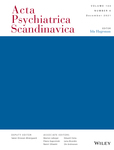Risk factors for suicide among patients having received treatment with electroconvulsive therapy: A nationwide study of 11,780 patients
Abstract
Objectives
Despite the putative anti-suicidal effect of electroconvulsive therapy (ECT), patients receiving ECT remain at high risk of dying from suicide due to the severity of their underlying mental illness. We aimed to quantify this risk and to identify risk factors for suicide among patients receiving ECT.
Methods
Using nationwide Danish registers, we identified all patients that initiated ECT between 2006 and 2016. These patients were matched on sex and age to 10 reference individuals from the general Danish population. Firstly, we compared 2-year suicide risk between patients initiating ECT and the matched reference individuals. Secondly, we investigated if any patient characteristics were associated with suicide following ECT via Cox proportional hazards regression.
Results
A total of 11,780 patients receiving ECT and 117,800 reference individuals were included in the analyses. Among the patients receiving ECT, 161 (1.4%) died from suicide within two years. Compared to the reference individuals, patients having received ECT had a substantially elevated suicide rate (Hazard rate ratio (HRR) = 44.48, 95%CI = 31.12–63.59). Among those having received ECT, the following characteristics were associated with suicide: Male sex (adjusted HRR (AHRR) = 2.32, 95%CI = 1.63–3.30), medium-term higher education (AHRR = 2.64, 95%CI = 1.57–4.44); long-term higher education (AHRR = 3.16, 95%CI = 1.68–5.94), history of substance use disorder (AHRR = 1.51, 95%CI = 1.01–2.26) and history of intentional self-harm/suicide attempt (AHRR = 4.18, 95%CI = 2.76–6.32).
Conclusions
Those who are male, have obtained medium-/long-term higher education, or have a history of substance use disorder or intentional self-harm/suicide attempt, are at particularly elevated risk of suicide following ECT. These findings may guide clinical initiatives to reduce suicides.

 求助内容:
求助内容: 应助结果提醒方式:
应助结果提醒方式:


